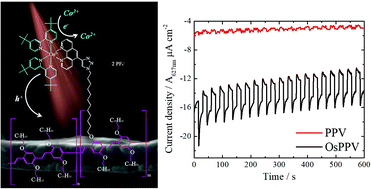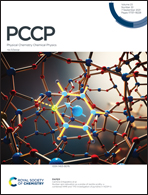Red-light sensitized hole-conducting polymer for energy conversion†
Abstract
We report a novel hole conductive polymer with photoactive Os(II) complexes in the side chains. This PPV derivative can be activated upon absorption of red visible light and delivers notable photocurrents when used as photocathode material. Thus, the polymer presents as a stepping stone towards developing soft matter alternatives to NiO photocathodes, which function under visible light irradiation. To show the concept we combine electrical impedance spectroscopy with steady state spectroscopy. As light-driven hole injection from Os complex to the PPV polymer is thermodynamically feasible both based on reductive quenching of photoexcited PPV and based on oxidative quenching of the photoexcited Os chromophores we investigate the impact of illumination wavelengths on the photocathode behavior and photochemical stability of the material. While both blue and red light excitation, i.e., excitation of the chromophoric units PPV and excitation of the metal-to-ligand charge transfer transitions in the side-chain pendant Os chromophores yield cathodic photocurrents, the photochemical stability is drastically enhanced upon red-light excitation. Hence, the results of the investigations discussed show the validity of the concept developing red-light sensitized hole-conducting polymers for energy conversion.



 Please wait while we load your content...
Please wait while we load your content...